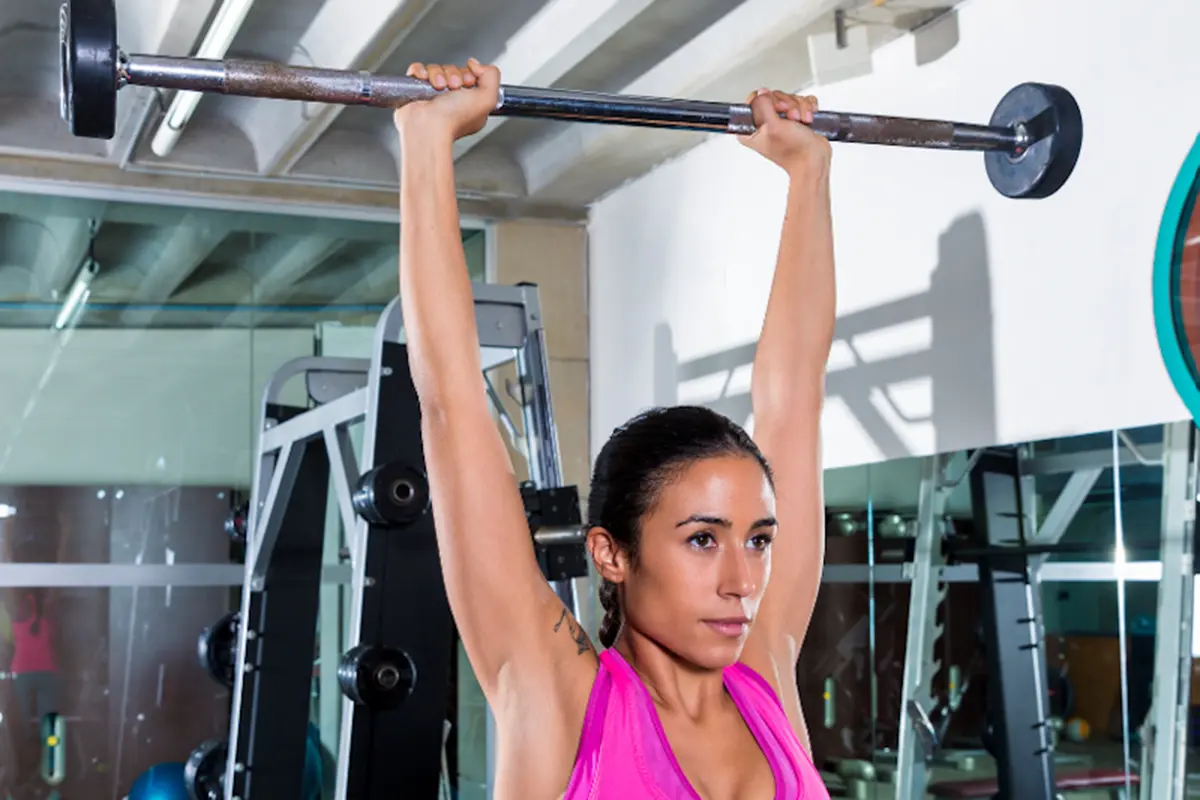The behind-the-neck press is a shoulder-focused movement — a variation of the overhead or shoulder press — that places the barbell behind your head as you press. It’s one of the more debated exercises in gyms because it can place considerable stress on the neck and shoulder region.
Although it can be performed safely, this lift isn’t suitable for everyone. Even experienced lifters should consider working with a qualified trainer to reduce risk.

How to perform it
You can perform the behind-the-neck press seated or standing. If you’re new to the movement, begin seated on a bench. Using a bench with an upright back provides added support.
- Sit with the barbell resting across your upper traps. Place your feet flat on the floor with knees at about 90 degrees.
- Grip the bar wider than shoulder-width with palms facing forward. Tighten your core and retract your shoulder blades, keeping your elbows under the bar.
- Exhale and press the bar straight up so it travels above and in line with your head. Hold briefly at the top.
- Inhale and lower the bar slowly back to the start.
- Begin with one set of 12–15 repetitions.
Once you can perform the seated version safely, you may progress to standing, which uses the same mechanics but starts from a rack. In either form, start light; a trainer can advise on appropriate loading.
Pro tips
- During the upward phase, avoid jutting your head or arching your back forward.
- The lowering phase should be controlled and deliberate — don’t let the bar drop back into place.
Muscles worked
The behind-the-neck press targets:
- The anterior, lateral, and posterior deltoids (shoulder muscles)
- The trapezius (upper back)
- The triceps brachii (back of the upper arm)
- The serratus anterior (along the rib cage beneath the armpit)
If performed standing, the lift also recruits the core and lower-body stabilizers.
Benefits
Training the shoulders, upper back, and upper arms improves overall upper-body strength and enhances shoulder stability and mobility.
Stronger shoulders support a variety of actions, including:
- Lifting
- Pulling
- Pushing
- Punching
Better shoulder stability and mobility can also lower the likelihood of shoulder discomfort and injury.
Is it dangerous?
The behind-the-neck press can subject the rotator cuff muscles — which stabilize the shoulder joint — to substantial load. The placement of the bar behind the head can be awkward; with limited shoulder mobility or excessive weight, there’s risk of muscle strain or tears.
There’s also potential for neck injury. On the descent the bar might contact the neck or the rear of the head, and the position can strain neck muscles.
Because of these hazards, only attempt this press if you have:
- Sufficient shoulder mobility and stability
- Normal trunk stability
- Good thoracic spine (upper back) mobility
If you’re unsure, consult a personal trainer to assess whether this exercise is appropriate for you. Avoid the movement if you have current or previous shoulder injuries.
Safer alternatives that give similar effects
If you’re worried about the risks of the behind-the-neck press, several variations and alternative lifts produce comparable shoulder benefits with reduced danger.
Below are safer options that still target the shoulders. If you’ve had shoulder issues, work with a trainer who can recommend further modifications.
1. Behind-the-neck press with dumbbells
Although typically performed with a barbell, using dumbbells for the behind-the-neck press can lower injury risk.
Dumbbells allow each arm to move independently rather than locking your arms into a fixed path. This freedom creates a more natural motion and tends to be gentler on the shoulders.
Dumbbells also enable a gradual increase in range of motion, whereas barbells often demand extreme extension and abduction.
To perform with dumbbells:
- Sit on a bench with feet flat and knees about 90 degrees. Rest the dumbbells on your thighs, then raise them to shoulder height one at a time with palms facing forward.
- Retract your shoulder blades and move your elbows back so the dumbbells sit behind your ears.
- Engage your core. Exhale and press the dumbbells straight up, keeping them aligned with your shoulders. Pause at the top.
- Inhale and lower slowly to the start.
- Begin with one set of 12–15 reps.
For a gentler option, perform the movement with a single dumbbell at a time to progressively build shoulder strength.
The standing dumbbell version is more challenging because it also taxes the core and legs; stand with feet shoulder-width apart and follow the same steps.

2. Standard shoulder press
The conventional shoulder press (barbell or dumbbell) is typically safer, since the weight is held in front of the body rather than behind the head.
Like the behind-the-neck variation, the standard shoulder press works the deltoids, triceps, and trapezius, and also engages the pectoral muscles.
To perform it:
- Sit with the barbell positioned just above your anterior shoulders. Feet flat and knees at 90 degrees. Grip the bar wider than shoulder-width with palms facing forward.
- Unrack the bar and hold it at chin level. Tighten your core, retract your shoulder blades, and point your elbows forward.
- Exhale and press the bar upward until it’s aligned with your head. Briefly pause at the top.
- Inhale and lower the bar back down in a controlled manner.
- Begin with one set of 12–15 repetitions.
You can also perform this press with dumbbells or while standing for increased core involvement.
Bottom line
The behind-the-neck press is a shoulder-targeting lift, but it places additional stress on the neck and shoulder complex, which is why many recommend avoiding it.
If your shoulder mobility and stability are limited, consider avoiding this exercise and opt for safer alternatives that develop shoulder strength without the added risk.


















Leave a Reply
You must be logged in to post a comment.